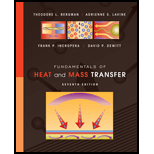
Concept explainers
Show that, for water at 1-atm pressure with
The physical significance of Jakob number for water and verify if this conclusion applies to other fluids and to show that Jakob number is unity for water.
Answer to Problem 10.1P
The Jakob number is less than unity for water and this applies to all the fluids which signify that Jakob number is always to be much less than unity.
Explanation of Solution
Given:
Pressure of water is
The temperature difference
Concept used:
Refer to table A-6 “Thermo physical properties of saturated water at pressure of 1.0133 bar” to obtain the value of heat of vaporization as
Write the expression for Jakob number of water.
Here,
Calculation:
Substitute
The value of Jakob number is
As the Jakob number is very less for water, it implies that the vapors absorbing latent heat is more than the vapors absorbing the sensible heat during the boiling phase change.
Check the value of Jakob number for other fluids like Ethylene glycol and mercury.
Refer to table A-5 “Thermo physical properties of saturated fluids at pressure of 1 atm” to obtain the value of heat of vaporization for ethylene glycol as
Substitute
Thus, the value of Jakob number for ethyl glycol is also than unity.
Refer to table A-5 “Thermo physical properties of saturated fluids at pressure of 1 atm” to obtain the value of heat of vaporization for mercury as
Substitute
Thus, the value of Jakob number for mercury is also than unity.
Conclusion:
Thus, the Jakob number is less than unity for water and this applies to all the fluids which signify that Jakob number is always to be much less than unity.
Want to see more full solutions like this?
Chapter 10 Solutions
Fundamentals of Heat and Mass Transfer
Additional Engineering Textbook Solutions
Thinking Like an Engineer: An Active Learning Approach (4th Edition)
Automotive Technology: Principles, Diagnosis, and Service (5th Edition)
Applied Statics and Strength of Materials (6th Edition)
Engineering Mechanics: Statics & Dynamics (14th Edition)
Fox and McDonald's Introduction to Fluid Mechanics
Heating Ventilating and Air Conditioning: Analysis and Design
- Develop a general expression for ΔSsys for an ideal gas that goes from (v1, T1) to (v2, T2) based on the path below.arrow_forwardWhat is the pressure on a pure water surface if it starts to boil at a temperature of 110C. (Answer 1777.2mb)Show every steparrow_forwardIdentify the state of the fluid: R134a at 400kPa, with a specific volume of 0.0223m3/kgarrow_forward
- Question : Determine the units of the quantity s ̄/Ru, where s ̄ is the molar specific entropy and Ru is the universal gas constant. Explain your answer pleasearrow_forwardQ6. The boiling temperature of water decreases by about 3°C for each 1000-m rise in altitude. What is the decrease in the boiling temperature in °F for each 1000-ft rise in altitude?arrow_forwardDetermine the specific volume, (v) of saturated water at P=3100 psia and x=25%.arrow_forward
- Three liquids given the following properties are poured into the cylindrical container with a diameter of 3 meters and a height of 6 meters. First fluid poured: sg = 1.0, V = 17.6715 m^3 Second fluid poured: sg = 0.81, V = 10.6029 m^3 Third fluid poured: sg = 2.94 , V = 7.0686 m^3 Assuming that the container is closed after pouring the fluids and the stable state in the container is reached, determine the pressure at the height of 4-m from the bottom of the tank Select the correct response 7.9461 kPa 12.8084 kPa 28.8414 kPa 9.8100 kPa Assuming seawater to have a constant specific weight of 10.05 kN/m^3, what is the absolute pressure at a depth of 10 km. Select the correct response(s): 939 atm 339 atm 993 atm 399 atmarrow_forward2.23- Water is at 20 °C and the pressure is lowered until boiling is observed. What is the pressure? from Engineering fluid mechanics 11tharrow_forwardThe tanks will befilled at 20 °C to a pressure of 100.0 atm. What maximum and minimum pressureswould you expect to observe in a full tank if the ambient temperature will rangefrom -20 °C to 30 °C?arrow_forward
- A capillary tube viscometer is being selected to measure viscosity of a liquid food. The maximum viscosity to be measured will be 230 cP and the maximum flow rate that can be measured accurately is 0.015 kg/min. If the tube length is 10cm and a maximum pressure of 25 Pa can be measured, determine the tube diameter to be used. The density of the product is 1000 kg/m3.arrow_forwardCalculate the maximum amount of water that can be poured into a 50-liter container at a temperature of 15°C so that at 200°C the increase in pressure is not greater than 50 atm. Take the isothermal compressibility of water as B = 4.80x10-5 atm^ -1 and the coefficient of volumetric expansion is a=0.798x10-3 K^-1 Solve as early as you can with right answers.arrow_forwardA 50-cm × 30-cm × 20-cm block weighing 150 N is to be moved at a constant velocity of 1.10 m/s on an inclined surface with a friction coefficient of 0.27. (a) Determine the force F that needs to be applied in the horizontal direction. (b) If a 0.40-mm-thick oil film with a dynamic viscosity of 0.012 Pa⋅s is applied between the block and inclined surface, determine the percent reduction in the required force.arrow_forward
 Refrigeration and Air Conditioning Technology (Mi...Mechanical EngineeringISBN:9781305578296Author:John Tomczyk, Eugene Silberstein, Bill Whitman, Bill JohnsonPublisher:Cengage Learning
Refrigeration and Air Conditioning Technology (Mi...Mechanical EngineeringISBN:9781305578296Author:John Tomczyk, Eugene Silberstein, Bill Whitman, Bill JohnsonPublisher:Cengage Learning Principles of Heat Transfer (Activate Learning wi...Mechanical EngineeringISBN:9781305387102Author:Kreith, Frank; Manglik, Raj M.Publisher:Cengage Learning
Principles of Heat Transfer (Activate Learning wi...Mechanical EngineeringISBN:9781305387102Author:Kreith, Frank; Manglik, Raj M.Publisher:Cengage Learning

